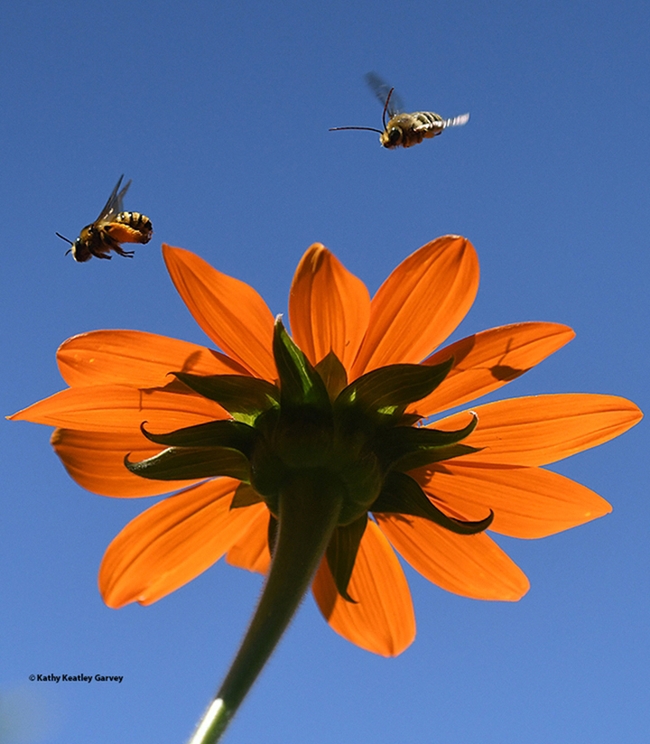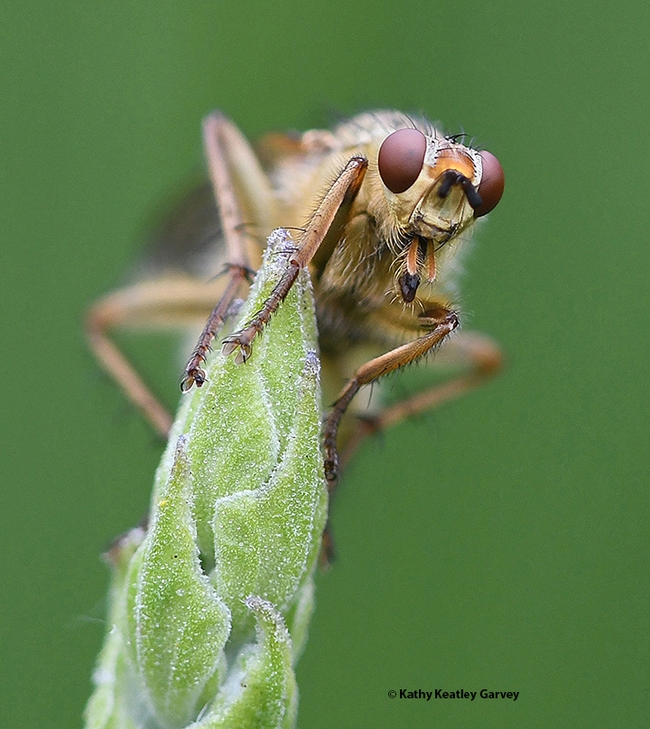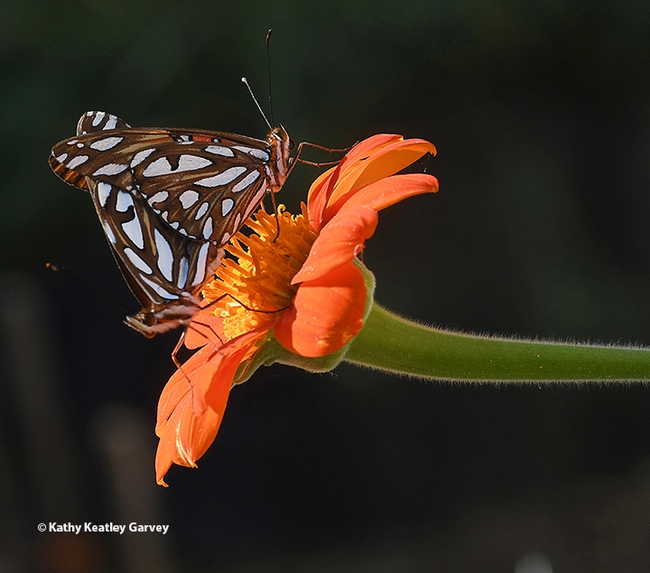- Author: Kathy Keatley Garvey
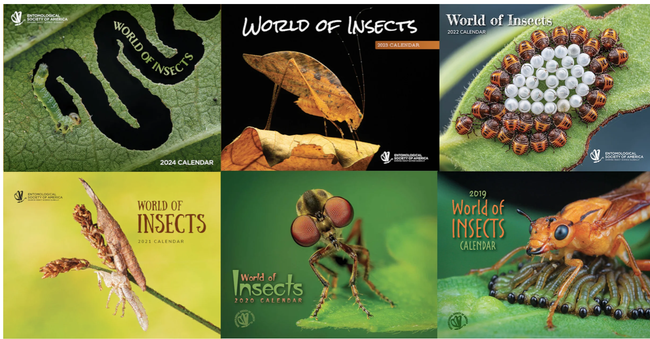
You'll see insects you've never seen before--and learn a little about them.
The cover image of the larva of the elm zigzag sawfly, Aproceros leucopoda (order Hymenoptera, family Argidae), native to Asia, is especially spectacular. It's the work of Christian Brockes of Germany.
"The elm zigzag sawfly is an east-Asian pest of elms (Ulmus spp), invasive in Europe since about 10 years ago and now also established in some North American regions," the ESA text relates. "The common name was inspired by the very distinctive patterns that their larvae leave on elm trees, while feeding. In large numbers, this species can critically damage elm populations. Often dozens of the tiny larvae--each only a few millimeters long--can be found on a single leaf, which they can skeletonize in a short period of time."
Scientists first detected this pest in the United States (Virginia) in 2021. Since 2022, it's been confirmed in four other states: Pennsylvania, North Carolina, Maryland and New York, according to research published in July 2023 in the Journal of Integrated Pest Management. The elm zigzag sawfly feeds exclusively on elms (Ulmus spp). It draws its name from the zizag-shaped pattern on the leaves as the larvae feed.
ESA prides itself on publishing world-class photography. Among the eight judges this year: Alex Wild, curator of entomology at the University of Texas and a doctoral alumnus from UC Davis. Wild studied with ant specialist Phil Ward, professor of entomology, UC Davis Department of Entomology and Nematology.
ESA issues a call for photos every January, and publishes the calendar every November. Of added interest, unselected images may appear on social media in the ESA's weekly "Arthropod Photo of the Week." Follow "Arthropod Photo of the Week" via the #arthropodPOTW hashtag on Twitter, Facebook, Instagram, and Mastodon.
We remember that an image of a hoverfly by UC Davis alumnus Alexander Nguyen appeared in the 2015 World of Insects Calendar. (See UC Davis of Entomology and Nematology website.) Judges chose his photo as one of the 12 winning images from a field of 560 entries submitted by 133 photographers from multiple continents. Nguyen captured the image at the UC Davis Stebbens Cold Canyon Reserve in April 2017, using his Canon 7D camera and a MPE 65-mm lens. Senior insect biosystematist Martin Hauser of the California Department of Food and Agriculture identified the hover fly as a male Platycheirus trichopus (Thomson, 1869).
What images are in the 2024 calendar? You'll see an ant tending treehopper nymphs, a chalcid wasp on Hemipteran eggs, stingless bees, a sunburst diving beetle, a Baltimore checkerspot butterfly, a Corsican owlfly, an ant-mimicking crab spider, a giant silk moth, an ambush bug preying on a bumble bee, a chestnut weevil, a poplar sphinx moth and an East Asian red damselfly. In addition, images that won honorable mentions share space on the calendar.
You can order the calendar here.
The 7000-member ESA, founded in 1889 and located in Annapolis, Md., is the world's largest entomological organization. It is affiliated with educational institutions, health agencies, private industry and government. Members are researchers, teachers, extension service personnel, administrators, marketing representatives, research technicians, consultants, students, pest management professionals, and hobbyists.
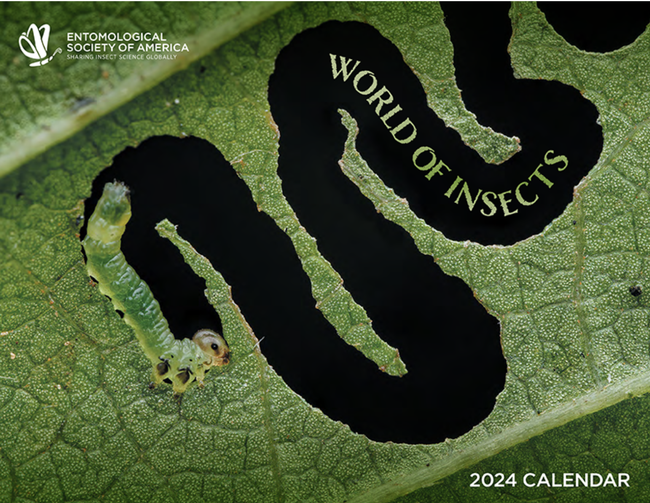
- Author: Kathy Keatley Garvey
Congratulations to UC Davis doctoral students Shawn Christensen, Lexie Martin and Iris Quayle!
They each won the President's Prize (first-place) for their graduate student research presentations this week at the Entomological Society of America (ESA) meeting in National Harbor, Md.
That's quite a feat and well-deserved! From bees to beetles...
Shawn and Lexie are members of the lab of associate professor and community ecologist Rachel Vannette, who serves as vice chair of the UC Davis Department of Entomology andNematology. Iris studies with professor and arachnologist Jason Bond, the Evert and Marion Schlinger Endowed Chair in Insect Systematics for the department, and associate dean, College of Agricultural and Environmental Sciences.
Shawn competed in the Plant-Insect Ecosystems (P-IE) Section, Apiculture; Lexie in the P-IE Section, Pollinator Biology; and Iris in Systematics, Evolution, and Biodiversity (SysEB) Section, Biogeography.
Shawn, who has advanced from doctoral student to doctoral candidate, presented his research, titled "Bee Specific! Solitary Bee (Anthophora bomboides) Hosts a Specialized Core Microbiome through Development." Lexie delivered her presentation on "Establishment and Health Impacts of Floral and Intraspecific Microbes in Bees." And Iris? “Colorless but Never Dull: Unraveling Population Genetics and Color Evolution in ‘White' Darkling Beetles (Onymacris).” (See news story)
Iris earlier won first-place for her graduate student presentation at the annual meeting of the Pacific Branch of ESA (PBESA), held in April in Seattle. This was her first-ever presentation at a scientific meeting. “Iris has hit the ground running in all respects," Professor Bond commented at the time. "Winning the student paper award, the first time ever presenting her research, reflects her exceptional capabilities as a scientist and as a future professor and teacher. Iris comes from a non-traditional STEM background and it is exactly those experiences that will continue to contribute to her success as she evolves as a scientist. I predict that this is only a prelude of things to come.”
Iris is focusing her dissertation on the evolutionary relationships and color/trait evolution in Onymacris. Tenebrionidae (darkling beetles) comprise “more than 80 percent of all known beetle species in the Namib desert (Southern Africa) where the genus Onymacris contains a rarity unexpected from aptly named darkling beetles--the presence of several species with striking ‘white' elytra (wing sheaths).” (See news story)
The complete list of student winners--first, second and third places--is posted on the ESA site.
Founded in 1889, ESA is the largest entomological organization in the world. Its more than 7,000 members are affiliated with educational institutions, health agencies, private industry, and government.
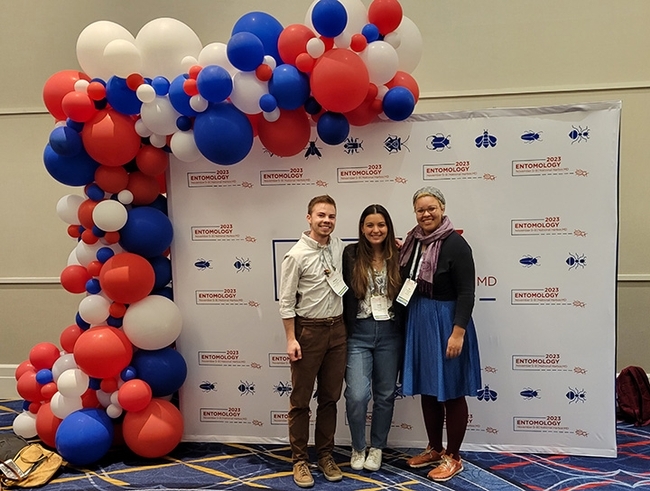
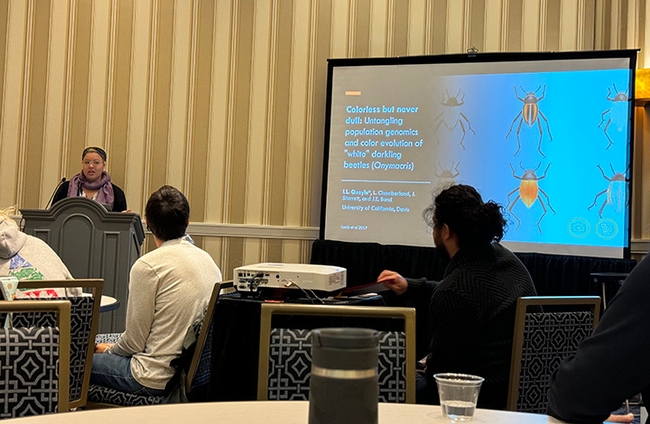
- Author: Kathy Keatley Garvey

The annual meeting, hosted by the Entomological Society of America (ESA), is taking place Nov. 5-8 at the Gaylord National Resort and Convention Center in National Harbor, Md.
The theme: "Insects and Influence: Advancing Entomology's Impact on People and Policy."
At the helm of ESA this year--and influencing scientists, insects and the general public--are four women scientists:
- President: Marianne Alleyne, University of Illinois at Urbana-Champaign
- Vice President: Jennifer Henke, Coachella Valley Mosquito and Vector Control District
- Vice President-Elect: Lina Bernaola, Texas A&M University
- Past President: Jessica Ware, American Museum of Natural History
Among the top honorees at Entomology 2023 is UC Davis doctoral alumnus Douglas Walsh, professor and Extension specialist in the Department of Entomology, Washington State University (WSU). He is one of six newly elected Fellows
"Walsh is known internationally for his research on the modes of action and resistance mechanisms of acaricides on spider mites and regionally in the Pacific Northwest for his extension and outreach efforts on specialty crops," ESA announced in a news release, citing that:
"Walsh has maintained a well-funded (more than $30 million) and productive program as the research director of the Environmental and Agricultural Entomology Laboratory located at the WSU Irrigated Agriculture Research and Extension Center in the Yakima Valley near Prosser, Washington. Walsh is the Extension integrated pest management (IPM) coordinator for Washington State and the Washington State liaison representative to the U.S. Department of Agriculture IR-4 Project."
"Walsh has an extensive and varied integrated pest and pollinator management research and Extension program assisting regionally important commodities including hops, alfalfa, grapes, and mint. Walsh also directs environmental impact studies on alfalfa leafcutting and alkali bees, the key pollinators of alfalfa produced for seed. Walsh's efforts in IPM have resulted in the documented reduction of over 100,000 pounds of insecticide use in the Pacific Northwest annually."
Born in New York in 1963 and a resident of California since 1969, Walsh holds a bachelor's degree in biology from UC Santa Cruz (1985). He received his doctorate in entomology from UC Davis in 1998, studying with major professor Frank Zalom, who went on to become a UC Davis distinguished professor and president and Honorary Member of ESA. "He is very deserving," Zalom said. "I couldn't be more proud of all that he has accomplished." Zalom is now emeritus, but continues to do research.
"I was Frank's first PhD student," Walsh said. "Frank had one before me, Rachid Hanna. Frank picked up Rachid when Rachid was orphaned when his original professor left UC Davis. Rachid and I quibble about who was Frank's first student. I'm the first that went from start to finish with Frank."
"(Professors) Sean Duffy and Harry Kaya were also on my PhD committee," Walsh said.
Outstanding Graduate Student. Kaya remembers Walsh well. "He was studying integrated pest management at UC Davis and was an outstanding graduate student in Frank Zalom's lab," Kaya said. "Even as a graduate student, he published some significant papers on IPM research, and I had no doubt that he would excel in research in his post graduate years. He has not only done superb IPM research but has been a leader in the Entomological Society of America as well as other national and international organizations. He richly deserves being elected as an ESA Fellow."
Walsh joined the WSU Department of Entomology as assistant professor in 1998 and advanced to associate professor in 2003 and to professor in 2007. The author of more than 200 publications, he annually delivers more than 35 Extension presentations. He has mentored 12 doctoral students and 11 master's degree students.
Walsh served as president of the Pacific Branch of ESA (PBESA) in 2010 and represented PBESA on the ESA governing board from 2013 through 2019. Among his ESA awards: Excellence in IPM Award and he led two teams that received the IPM Team Award.
A WSU news story (Sept. 7, 2023) related that Walsh has "worked primarily on pest control issues, mostly on hops, grape vines, mint, and alfalfa. One of his first successes at WSU in 2005 involved developing a novel method for controlling cutworms, which climb up from the soil in spring to nibble on grapevine buds."
Walsh initially set out to become a botanist. “I was working in a local Extension office in California after I got my bachelor's degree," he told the WSU writer Scott Weybright. "That work involved battling spider mites on strawberries. I kind of fell into entomology, but I love the work and the creative solutions we find to help growers."
His wife, Catherine (Kikie) is a senior software engineer with Altera Digital, a hospital software firm. The couple, married 35 years, raised three children, Claire, Russ, and Jeff, all WSU grads. Claire is the lifecycle marketing manager with Niantic Labs; Russ is working toward his master's degree in teaching at WSU Tri-Cities: and Jeff is a site reliability engineer at TikTok.
Other newly inducted ESA Fellows are:
- Cassandra Extavour, Harvard University
- James Hagler, U.S. Department of Agriculture-Agricultural Research Service
- Alvin M. Simmons, U.S. Department of Agriculture-Agricultural Research Service
- Lukasz Stelinski, University of Florida
- Edward L. Vargo, Texas A&M University
Founded in 1889, ESA is a worldwide organization of more than 7000 members, who are affiliated with educational institutions, health agencies, private industry, and government. Members are researchers, teachers, extension service personnel, administrators, marketing representatives, research technicians, consultants, students, pest management professionals, and hobbyists.

- Author: Kathy Keatley Garvey
If you enjoy taking images of insects and spiders, enter the 65th international Insect Salon competition. The deadline is Oct. 28.
The contest, open to photographers throughout the world, is sponsored by the Peoria Camera Club, Illinois, in conjunction with the Entomological Society of America (ESA) and the Photographic Society of America.
Coordinator Joe Virbickis of the Peoria Camera Club said the images are restricted to insects, spiders, and related arthropods (such as barnacles, crabs, lobsters, shrimp, centipedes, and millipedes.)
You don't have to be an ESA or a PCC member to enter. You can enter four images for a total cost of $10. Entries are restricted to insects, spiders, and related arthropods (such as barnacles, crabs, lobsters, shrimp, centipedes, and millipedes)
The awards:
Best of Show (PSA Gold Medal)
Peoria Camera Club (PCC) Medals: Most Unusual Image; Best Story Telling Image; Best Image by an ESA Member; Best Image by a Non-ESA Member; Best Image by Peoria Camera Club Member.
2022 Best of Show. The Best of Show medal went to Kenneth Gillies of West Lothian, Scotland, United Kingdom, for his “Peppermint Shrimps Inside a Sponge.”
Gillies was joined by the five other top winners:
- Medal for Most Unusual Image: Weihua Ma of Guangzhou City, Guangdong Province, China, for “Pretending to be a Branch.”
- Medal for Best Storytelling Image: Dre Van Mensel of Tielen, Antwerpen, Belgium, for “It's Mine.”
- Medal for Best Image by a ESA member: Kathy Keatley Garvey (yours truly) of UC Davis/Vacaville, Calif., for “Checking You Out.” of a golden dung fly, Scathophaga stercoraria.
- Medal for Best Image by a non-ESA member, Tim Sanders of Bideford, Devon, England, for “At Work.”
- Medal for Best Peoria Camera Club member: Ladean Spring of Creve Coeur, lll., for “Hummingbird Moth.”
See the 2022 winning entries at https://insectsalon.peoriacameraclub.com/results/2022/Html/sect_1.htm
The theme for Entomology 2023 is “Insects and Influence: Advancing Entomology's Impact on People and Policy.” The 7000-member ESA, founded in 1889 and located in Annapolis, Md., is the world's largest entomological organization. It is affiliated with educational institutions, health agencies, private industry and government. Members are researchers, teachers, extension service personnel, administrators, marketing representatives, research technicians, consultants, students, pest management professionals, and hobbyists.
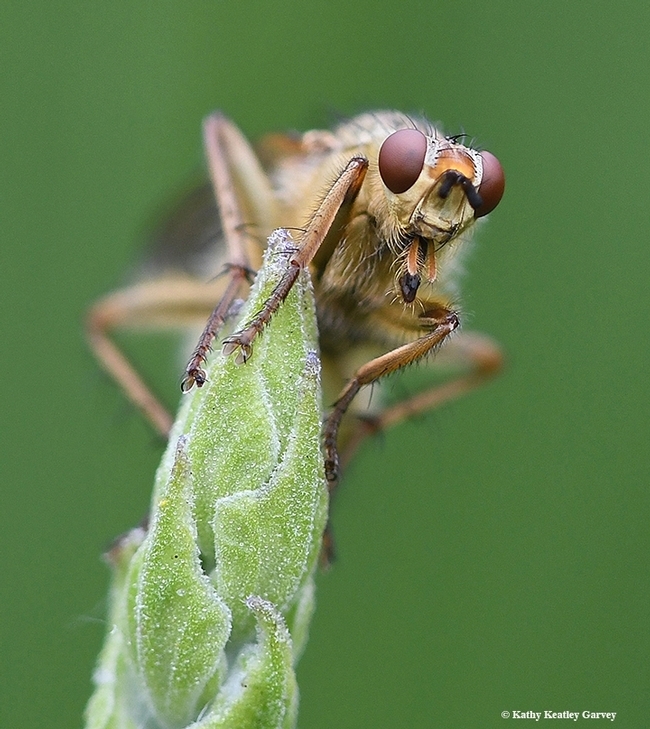
- Author: Kathy Keatley Garvey
This is the story of how two native bees from Vacaville, Calif., traveled 1872 miles to Oklahoma City.
Not really.
But a photo I took in Vacaville of two Melissodes agilis bees zipping over a Mexican sunflower, Tithonia rotundifola, happened to win a top prize at the 63rd North Central Insect Photographic Salon, co-sponsored by the North Central Branch of the Entomological Society of America (ESA) and the Photographic Society of America.
Judges scored it "Best Image by an ESA Member." All 7000 ESA members are invited to contribute, as are non-members. I wasn't planning to enter--this was my first time--but Insect Salon coordinator/ESA member Tom Myers posted a note on Facebook seeking images to be showcased at the 2023 Joint North Central and Southwestern Branch meeting in Oklahoma City. The theme: "Branch Cross-Pollination: Seeking Hybrid Vigor in Science through Communication, Collaboration, and Societal Impact."
The North Central Branch covers Colorado, Illinois, Indiana, Iowa, Kansas, Kentucky, Michigan, Minnesota, Missouri, Nebraska, North Dakota, Ohio, South Dakota, Wisconsin, plus parts of Canada (Manitoba, Nunavut, Ontario) while the Southwestern Branch encompasses New Mexico, Oklahoma and Texas, and all of Mexico, except Baja California, Baja California Sur, Sinaloa and Sonora.
To be accepted for display, a photo must score 85 points or more. The image of the male and female bees, which I titled "Catch Me If You Can," scored 94 points, and two other Garvey images, one of a golden dung fly (Scathophaga stercoraria), "Checking You Out," and the other titled "I Do," of two Gulf Fritillaries (Agraulis vanillae), tallied 92 and 89 points, respectively. "Checking You Out" earlier won "Best Image by an ESA Member" in the 64th annual International Insect Salon competition.
The M. agilis species are fun to photograph, but set your shutter speed high. These bees are the Usain Bolts of the bee world. Catch me if you can!
I captured the image of "Catch Me If You Can" with a Nikon D500, mounted with a 200mm lens. Settings: shutter speed set at 1/8000 of second, f-stop 5, and ISO 800.
For "Checking You Out:" Nikon D500 with a 105mm lens, 1/320 of second, f-stop 9, and ISO 800.
For "I Do": Nikon D500 with a 70-180 lens (110 focal length), 1/640 of a second, f-stop at 10, and ISO of 800.
All were taken in our family's pollinator garden. (No tripod, no flash.) The added benefit of planting a pollinator garden includes capturing images of the residents and visitors.
Me? I'm just a guest in their habitat. I don't poke 'em, prod 'em or pin 'em. I just photograph them. When. They. Let. Me.
